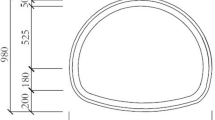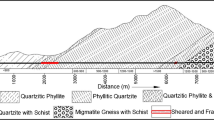Abstract
The twin tube, 1,765 m long Hanekleiv road tunnel is located in Southeast Norway. Ten years after completion of the tunnel, a serious rock fall occurred in the southbound tube, approximately 1.1 km from the northern tunnel entrance, in a fault zone containing swelling clay. In addition to swelling, gravitational collapse due to the very low internal friction played an important role in the development of the instability. Numerical analysis has been carried out for the rock slide. Modelling based on the support actually applied indicated cracks during tunnel excavation as well as the tunnel collapse. Simulation showed that even reinforced shotcrete ribs or 25 cm thick concrete lining, based on the Q-system, may not be sufficient for the fault zone.
Résumé
Le tunnel routier bi-tube de Hanekleiv, de 1,765 m de longueur, est situé dans le sud-est de la Norvège. Dix ans après l’achèvement de la construction du tunnel, un important éboulement a eu lieu dans le tube sud, approximativement à 1,1 km de l’entrée nord du tunnel, au niveau d’une zone de faille où des argiles gonflantes étaient présentes. Associé au gonflement de ces argiles, de très faibles valeurs des angles de frottement interne des matériaux expliquent le développement de l’instabilité. Une analyse numérique a été réalisée pour ce qui concerne le glissement rocheux. Une modélisation portant sur le soutènement réellement appliqué a montré qu’une fissuration des terrains pendant la phase d’excavation ainsi qu’un éboulement étaient prévisibles. Une simulation numérique a montré que même des anneaux de béton projeté renforcés ou un revêtement de béton de 25 cm d’épaisseur, défini à partir du Q-système, pouvaient ne pas être suffisants au niveau de cette zone de faille.













Similar content being viewed by others
References
Bollingmo P, Nilsen B, Nordgulen Ø (2007) The cave-in at the Hanekleiv tunnel, 25 December 2006. Report from investigation panel established by the Norwegian Department of Transportation (in Norwegian), 14 February 2007
Brekke TL (1965) On the measurement of the relative potential swellability of hydrothermal montmorillonite clay from joints and faults in Precambrian and Paleozoic rocks in Norway. Int J Rock Mech Min Sci 2:155–165
Brekke TL, Selmer-Olsen R (1965) Stability problems in underground constructions caused by montmorillonite-carrying joints and faults. Eng Geol 1(1):3–19
Hanssen TH (1998) Rock stresses and tectonic activity. In: Proceedings of the Norwegian National Rock Mechanics Conference. Oslo, pp 29.1–29.24
Holmøy KH (2002) Significance of geological parameters for predicting water leakage in hard rock tunnels. PhD Thesis, NTNU, Trondheim, p 8
Itasca (2009) Fast lagrangian analysis of continua in 3 dimensions, version 4.0, user's manual. In: Itasca I (ed) Consulting Group, Minneapolis, Minnesota, USA
Mao D, Nilsen B, Lu M (2011) Analysis of loading effects on reinforced shotcrete ribs caused by weakness zone containing swelling clay. Tunn Undergr Space Technol 26:472–480
Nilsen B (2011) Cases of instability caused by weakness zones in Norwegian tunnels. Bull Eng Geol Environ 70:7–13
Nilsen B, Dahlø TS (1994) A study of cases of instability in hard rock tunnel. In: Proceedings of 7th IAEG Congress. Lisbon, vol. VI, Balkema, pp 4233–4242
Nilsen B, Palmstrøm A (2009) Engineering geological key factors for planning and constructing hard rock subsea tunnels. In :Proceedings of the 5th Symposium on Strait Crossings. Trondheim, pp 403–408
Norwegian Geotechnical Institute (NGI) (2011) http://www.ngi.no/en/Contentboxes-and-structures/Reference-Projects/Reference-projects/Q-method/
Norwegian Group for Rock Mechanics (NBG) (2000) Engineering geology and rock engineering, Hanbook NO. 2. Oslo, Norway, p 192
Norwegian Public Roads Administration (2004) Manual of road tunnels, Handbook No. 021. Oslo, Norway, pp 31 - 38
Reynolds P (2007) Finding fault at Hanekleiv. Tunnels and Tunnelling International, pp 14–16
Selmer-Olsen R, Palmstrøm A (1989) Tunnel collapses in swelling clay zones. Tunn Tunn 21:49–51
SINTEF Rock Engineering Group (2005) Test procedure for swelling pressure measurement (In Norwegian). Internal Report. NTNU, Norway
Tyssekvam IO (1996) Sampling and characterization of swelling material in weakness zones (In Norwegian), Diploma Thesis. NTNU, Trondheim
Acknowledgments
Professor Stephen Lippard is gratefully acknowledged for improving the language of the paper.
Author information
Authors and Affiliations
Corresponding author
Rights and permissions
About this article
Cite this article
Mao, D., Nilsen, B. & Lu, M. Numerical analysis of rock fall at Hanekleiv road tunnel. Bull Eng Geol Environ 71, 783–790 (2012). https://doi.org/10.1007/s10064-012-0438-3
Received:
Accepted:
Published:
Issue Date:
DOI: https://doi.org/10.1007/s10064-012-0438-3




